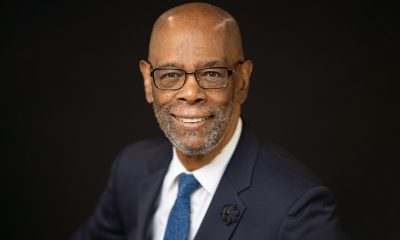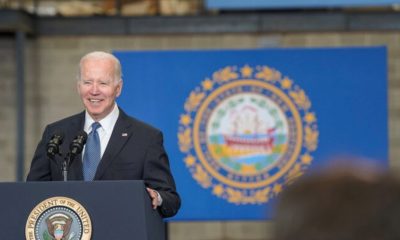Business
What Charter-Time Warner Cable Deal Could Mean for Consumers

This Feb. 2, 2009 file photo shows a Time Warner Cable truck in New York. Charter Communications is close to buying Time Warner Cable for about $55 billion, two people familiar with the negotiations said Monday, May 25, 2015. (AP Photo/Mark Lennihan, File)
TALI ARBEL, AP Business Writers
BREE FOWLER, AP Business Writers
NEW YORK (AP) — As the Internet has upended their business, cable companies have been racing to reinvent themselves as dominant broadband providers and distributors of online video.
Charter Communications’ $55 billion bid for Time Warner Cable, paired with a $10 billion side offer for Bright House Networks, marks the latest in a wave of deals that promise consumer benefits.
Perhaps so. Over the long run, though, critics say the collective weight of such deals may mean higher prices for subscribers.
In an accelerating trend, cable providers now have more Internet subscribers than TV subscribers, according to data provider SNL Kagan. As more viewers ditch TV for online video, competition for eyeballs is intensifying — from the likes of Netflix and Amazon to AOL to music-streaming service Spotify.
Here’s what that the Charter-TWC deal and others like it could mean over time:
Q: WHAT’S DRIVING THESE DEALS?
A: Cable companies are bulking up as costs for TV channels and sports rise even as the number of cable and satellite TV subscribers slips. The number of such subscribers declined around 500,000 over the 12 months that ended in March, according to data provider SNL Kagan.
Q: WILL REGULATORS LIKELY APPROVE THESE MERGERS?
A: It isn’t automatic. Earlier this year, Comcast Corp. dropped its own takeover bid for Time Warner Cable in the face of resistance from federal regulators. That proposed deal would have married the nation’s two biggest cable providers with a media powerhouse, Comcast’s NBCUniversal. Regulators worried that the combination would be too dominant in high-speed Internet service and might undermine the streaming-video industry that is changing TV viewing.
The Federal Communications Committee chairman, Tom Wheeler, upped the ante Tuesday, saying that “an absence of harm is not sufficient.” He said the FCC “will look to see how American consumers would benefit” from a Charter-TWC deal.
In its favor, Charter’s tie-up with TWC and Bright House isn’t as big as Comcast alone. And it doesn’t include a big entertainment company like NBCUniversal that could incentivize it to promote its own content.
Analysts expect the government to approve AT&T’s purchase of satellite TV company DirecTV, which does compete directly with the cable guys.
France’s Altice S.A., which was reportedly also interested in Time Warner Cable, last week bought a controlling stake in Suddenlink Communications. Altice declined to comment Tuesday.
Q: WOULD A CHARTER-TWC DEAL SERVE CONSUMERS?
A: Time Warner Cable has a terrible reputation for customer service. That could improve in the proposed merger. Charter said it’s been adding U.S. customer-service jobs and will continue to do so.
Charter also has simpler offers without a lot of hidden fees, said Jeff Wlodarczak, an analyst for Pivotal Research Group who says he think that the deal would be a net positive for consumers.
Charter argues that TWC customers would receive superior products — from faster broadband to expanded video offerings to additional high-definition channels. Charter says its slowest Internet speed — $40 a month for 60 megabits per second when bought by itself — is faster and cheaper than what Time Warner Cable offers. (Time Warner Cable advertises 30 megabits per second for $55 a month on its website.)
Charter says it would offer that option to Time Warner Cable customers, though prices could always change.
As a more national company, Charter could also compete better with phone companies that serve business customers, says Bruce Leichtman, a TV consultant and head of Leichtman Research Group.
Q: DO BIGGER CABLE COMPANIES MEAN HIGHER PRICES?
A: Internet prices have been rising and will likely keep doing so, said Forrester analyst James McQuivey. Still, he cautioned, it’s difficult to make any confident predictions at a time of rapid transformation in the industry and rising competition from online video.
“This is really a hard thing to say — because of x, y is going to happen, because there are about a dozen x’s in motion at the same time,” McQuivey said.
Some think differently. Cable companies already have scant competition for supplying Internet service, said Susan Crawford, co-director of the Berkman Center for Internet & Society at Harvard.
“High-speed Internet access today is a utility” that’s essential for education and job searching, Crawford noted. “Yet in American cities, cable is the dominant provider of that private utility and can charge whatever it wants to whoever it wants.”
For a provider, being big means you command better prices on TV and sports. That makes it harder for a new competitor like Google Fiber to offer attractive bundles of Internet and TV together.
Google Fiber exists in just three markets. In Kansas City, its presence made Time Warner Cable change its practices for the better, Crawford said.
Q: WHAT ABOUT CHEAP INTERNET TV?
A: Netflix and Hulu start at $8 a month. Amazon’s video library is part of its Prime shipping service, which costs $8.25 a month. HBO Now, which gives you HBO content without a cable subscription, is about $15 a month.
But as cable companies get bigger, they may make online video services pay more for access to their Internet customers. That could lead to higher prices.
By getting larger, cable companies can “control change in a more profitable manner,” said Nathan Miller, an economics professor at Georgetown University and formerly an economist with the Justice Department’s antitrust division. The risk, he said, is that companies can then charge more.
The FCC’s new Internet traffic rules, which broadband providers are suing to block, authorize it to investigate arrangements between Internet companies and broadband providers. That authority could help keep costs from rising substantially and being passed on to consumers.
Still, no one knows for sure how the industry’s transformation will affect prices.
“What any given deal means in terms of the ultimate price consumers pay — that’s a very difficult question to answer,” said Amanda Wait, a former Federal Trade Commission lawyer who represents clients in antitrust matters. “The analysis is more than just price. Do consumers have access to more content, higher broadband speeds? All those go into a consumer benefit analysis.”
Copyright 2015 The Associated Press. All rights reserved. This material may not be published, broadcast, rewritten or redistributed.
Activism
California Rideshare Drivers and Supporters Step Up Push to Unionize
Today in California, over 600,000 rideshare drivers want the ability to form or join unions for the sole purpose of collective bargaining or other mutual aid and protection. It’s a right, and recently at the State Capitol, a large number of people, including some rideshare drivers and others working in the gig economy, reaffirmed that they want to exercise it.

By Antonio Ray Harvey
California Black Media
On July 5, 1935, President Franklin D. Roosevelt signed into federal law the National Labor Relations Act (NLRA). Also known as the “Wagner Act,” the law paved the way for employees to have “the right to self-organization, to form, join, or assist labor organizations,” and “to bargain collectively through representatives of their own choosing, according to the legislation’s language.
Today in California, over 600,000 rideshare drivers want the ability to form or join unions for the sole purpose of collective bargaining or other mutual aid and protection. It’s a right, and recently at the State Capitol, a large number of people, including some rideshare drivers and others working in the gig economy, reaffirmed that they want to exercise it.
On April 8, the rideshare drivers held a rally with lawmakers to garner support for Assembly Bill (AB) 1340, the “Transportation Network Company Drivers (TNC) Labor Relations Act.”
Authored by Assemblymembers Buffy Wicks (D-Oakland) and Marc Berman (D-Menlo Park), AB 1340 would allow drivers to create a union and negotiate contracts with industry leaders like Uber and Lyft.
“All work has dignity, and every worker deserves a voice — especially in these uncertain times,” Wicks said at the rally. “AB 1340 empowers drivers with the choice to join a union and negotiate for better wages, benefits, and protections. When workers stand together, they are one of the most powerful forces for justice in California.”
Wicks and Berman were joined by three members of the California Legislative Black Caucus (CLBC): Assemblymembers Tina McKinnor (D-Inglewood), Sade Elhawary (D-Los Angeles), and Isaac Bryan (D-Ladera Heights).
Yvonne Wheeler, president of the Los Angeles County Federation of Labor; April Verrett, President of Service Employees International Union (SEIU); Tia Orr, Executive Director of SEIU; and a host of others participated in the demonstration on the grounds of the state capitol.
“This is not a gig. This is your life. This is your job,” Bryan said at the rally. “When we organize and fight for our collective needs, it pulls from the people who have so much that they don’t know what to do with it and puts it in the hands of people who are struggling every single day.”
Existing law, the “Protect App-Based Drivers and Services Act,” created by Proposition (Prop) 22, a ballot initiative, categorizes app-based drivers for companies such as Uber and Lyft as independent contractors.
Prop 22 was approved by voters in the November 2020 statewide general election. Since then, Prop 22 has been in court facing challenges from groups trying to overturn it.
However, last July, Prop 22 was upheld by the California Supreme Court last July.
In a 2024, statement after the ruling, Lyft stated that 80% of the rideshare drivers they surveyed acknowledged that Prop 22 “was good for them” and “median hourly earnings of drivers on the Lyft platform in California were 22% higher in 2023 than in 2019.”
Wicks and Berman crafted AB 1340 to circumvent Prop 22.
“With AB 1340, we are putting power in the hands of hundreds of thousands of workers to raise the bar in their industry and create a model for an equitable and innovative partnership in the tech sector,” Berman said.
Activism
Newsom Fights Back as AmeriCorps Shutdown Threatens Vital Services in Black Communities
“When wildfires devastated L.A. earlier this year, it was AmeriCorps members out there helping families recover,” Gov. Newsom said when he announced the lawsuit on April 17. “And now the federal government wants to pull the plug? We’re not having it.”

By Bo Tefu
California Black Media
Gov. Gavin Newsom is suing the federal government over its decision to dismantle AmeriCorps, a move that puts essential frontline services in Black and Brown communities across California at risk, the Governor’s office said.
From tutoring students and mentoring foster youth to disaster recovery and community rebuilding, AmeriCorps has been a backbone of support for many communities across California.
“When wildfires devastated L.A. earlier this year, it was AmeriCorps members out there helping families recover,” Newsom said when he announced the lawsuit on April 17. “And now the federal government wants to pull the plug? We’re not having it.”
The Department of Government Efficiency (DOGE) under the Trump administration is behind the rollback, which Newsom calls “a middle finger to volunteers.”
Meanwhile, Newsom’s office announced that the state is expanding the California Service Corps, the nation’s largest state-run service program.
AmeriCorps has provided pathways for thousands of young people to gain job experience, give back, and uplift underserved neighborhoods. Last year alone, over 6,000 members across the state logged 4.4 million hours, tutoring more than 73,000 students, planting trees, supporting foster youth, and helping fire-impacted families.
The California Service Corps includes four paid branches: the #CaliforniansForAll College Corps, Youth Service Corps, California Climate Action Corps, and AmeriCorps California. Together, they’re larger than the Peace Corps and are working on everything from academic recovery to climate justice.
“DOGE’s actions aren’t about making government work better. They are about making communities weaker,” said GO-Serve Director Josh Fryday.
“These actions will dismantle vital lifelines in communities across California. AmeriCorps members are out in the field teaching children to read, supporting seniors and helping families recover after disasters. AmeriCorps is not bureaucracy; it’s boots on the ground,” he said.
Activism
AI Is Reshaping Black Healthcare: Promise, Peril, and the Push for Improved Results in California
Black Californians experience some of the worst health outcomes in the state due to systemic inequities, limited healthcare access, and exclusion from medical research. 16.7% of Black adults report fair or poor health, versus 11.5% of Whites. Black adults have the highest death rates from prostate, breast, colorectal, and lung cancer. Statewide, diabetes affects 13.6% of Black adults versus 9.1% of Whites, and 27% of Black adults over 65 have heart disease, compared to 22% of Whites. Life expectancy for Black Californians is about five years shorter than the state average.

Joe W. Bowers Jr.
California Black Media
Artificial intelligence (AI) is changing how Californians receive medical care – diagnosing diseases, predicting patient needs, streamlining treatments, and even generating medical notes for doctors.
While AI holds promise, it also poses risks, particularly for Black patients. It can provide faster diagnoses and expand access to care, but it may also misdiagnose conditions, delay treatment, or overlook patient’s critical needs. AI’s impact on Black patients depends on how biases in medical data and algorithms are addressed in its development.
“As we progress toward a society with increased use of AI technology, it is critical that the biases and stereotypes that Black Americans have faced are not perpetuated in our future innovations,” said Dr. Akilah Weber Pierson (D – San Diego), a physician and state senator spearheading legislative efforts to address AI bias in healthcare.
Why AI Matters for Black Californians
Black Californians experience some of the worst health outcomes in the state due to systemic inequities, limited healthcare access, and exclusion from medical research. 16.7% of Black adults report fair or poor health, versus 11.5% of Whites. Black adults have the highest death rates from prostate, breast, colorectal, and lung cancer. Statewide, diabetes affects 13.6% of Black adults versus 9.1% of Whites, and 27% of Black adults over 65 have heart disease, compared to 22% of Whites. Life expectancy for Black Californians is about five years shorter than the state average.
Benefits and Risks of AI in Healthcare
AI processes vast amounts of medical data using computer algorithms designed to identify patient health patterns, helping doctors to diagnose diseases, recommend treatment, and increase patient care efficiency. By analyzing scans, lab results, and patient history, AI can detect diseases
earlier, giving it the potential to improve care for Black patients, who face higher risks of prostate cancer, diabetes, heart disease and hypertension.
Dr. Judy Gichoya, an Interventional radiologist at the Emory University Winship Cancer Institute and AI researcher at Emory’s Healthcare AI Innovation and Translational Informatics (HITI) Lab, sees AI as a tool with great potential but cautions that its effectiveness depends on the diversity of the data it is trained on. She says, “Without diverse datasets, AI could overlook critical signs of diseases, especially in underrepresented populations like Black patients.”
Dr. Timnit Gebru, a computer scientist and AI ethics expert, is the founder and Executive Director of DAIR (Distributed AI Research Institute) in Oakland. She has extensively studied bias in AI systems and their impact on marginalized groups.
Gebru acknowledges that AI has the potential to improve healthcare by enhancing efficiency and expanding access to medical resources. But, like Gichoya she strongly stresses that for AI to be effective and equitable it needs to be subject to rigorous oversight.
AI is already helping doctors personalize cancer treatment by identifying biomarkers and genetic mutations. UCSF and Stanford Health use AI to analyze tumor DNA to match patients with the most effective chemotherapy or immunotherapy.
In diabetes care, AI predicts blood sugar fluctuations, helping doctors adjust treatment. It helps radiologists in early disease detection and identifies sepsis sooner, reducing hospital deaths. In cardiology, AI detects early signs of heart disease, spotting plaque buildup or abnormal heart rhythms before symptoms appear. It also helps predict strokes by analyzing brain scans to determine risk and guide intervention.
Kaiser Permanente uses AI scribes to reduce paperwork and improve patient interactions. Covered California has partnered with Google
Cloud to use AI to streamline document verification and eligibility decisions.
Despite these advancements, AI systems trained on biased medical data can perpetuate inequities for Black patients.
Gebru explains, “If AI learns from historically discriminatory medical decisions—such as undertreating Black patients—it will scale those biases.”
A notable example is in dermatology, where AI frequently misdiagnoses conditions in Black patients because most training datasets are based on lighter-skinned individuals. “Melanoma looks very different on darker skin,” Gebru notes. “It’s not just darker—it often appears differently, like under toenails, a pattern AI trained mostly on lighter skin won’t detect.”
Another risk of AI in healthcare is automation bias, where healthcare providers over-rely on AI, even when it contradicts medical expertise. “Doctors who would have prescribed medications accurately without AI sometimes make mistakes while using automated tools because they over-trust these systems,” Gebru adds.
AI-driven health insurance claim denials are a growing concern. UnitedHealthcare faces a class-action lawsuit for allegedly using an unregulated AI algorithm to deny rehabilitation coverage to elderly and disabled patients.
Beyond bias, AI also poses an environmental threat. AI systems require enormous amounts of energy for computing and massive amounts of water to cool data centers, which exacerbates climate change, an issue that already disproportionately impacts Black communities.
Trump Administration and DEI Impact
The Trump administration’s efforts to dismantle Diversity, Equity, and Inclusion (DEI) threatens funding for AI bias research in healthcare.
Less federal support could stall progress in making AI systems fairer and more accurate, increasing discrimination risks for Black patients.
California’s Legislative and Regulatory Response
Recognizing AI’s risks in healthcare, California lawmakers and state officials are implementing regulations. Weber Pierson introduced Senate Bill (SB) 503 to ensure that AI algorithms used in healthcare are tested for racial bias before implementation.
“We’ve already seen how biased medical devices like pulse oximeters can fail Black patients,” Weber Pierson explains. “If algorithms used in patient care aren’t inclusive, they’re not going to accurately serve melanated individuals.”
At a press conference introducing SB 503, Weber Pierson stressed that AI must be held accountable. “This bill focuses on ensuring that software used as an accessory to healthcare staff delivers sound, nondiscriminatory decisions that promote equitable outcomes.”
Other legislative efforts include Senate Bill (SB) 1120, by Sen. Josh Becker (D-Menlo Park), which stops insurance companies from using AI alone to deny or delay care and Assembly Bill (AB) 3030, by Assemblymember Lisa Calderon (D-Whittier), which requires healthcare providers to inform patients when AI is used in their care.
Attorney General Rob Bonta has issued a legal advisory barring AI from unfairly denying healthcare claims, falsifying records, or restricting access to care based on medical history. Gov. Gavin Newsom’s 2023 executive order directs state agencies to assess AI’s impact and establish consumer protections, particularly in healthcare.
Actions Black Patients and Families Can Take
As AI becomes more common in healthcare, Black Californians can ensure fair treatment by asking if AI is used, seeking second opinions, and supporting groups addressing algorithmic bias.
They can:
- Ask their healthcare providers whether AI played a role in their diagnosis or treatment.
- Request second opinions if an AI-generated diagnosis seems questionable.
- Advocate for AI policies and legislation promoting fairness and accountability. · Engage with community health organizations like the California Black Health Network (CBHN) that is engaged in ensuring AI is developed in ways to improve health outcomes for Black patients.
Rhonda Smith, CBHN’s executive director, says bias in medical algorithms must be eliminated. “There should never be any race-based adjustment in delivering patient care,” she said.
CBHN supports inclusive research and legislation like SB 503 to ensure AI promotes equity.
Ensuring AI Benefits All Communities
As a legislator, Weber Pierson is pushing for stronger safeguards to ensure AI serves all patients equitably. She says, “Innovation and technology are good, but new challenges arise if we don’t move in a direction inclusive and thoughtful of all people who utilize the healthcare space.”
AI has the potential to revolutionize healthcare, but experts warn it must be developed and regulated with transparency, accountability, and fairness – ensuring it reduces rather than worsens, racial health disparities.
-

 Activism4 weeks ago
Activism4 weeks agoOakland Post Endorses Barbara Lee
-

 Activism3 weeks ago
Activism3 weeks agoOakland Post: Week of April 2 – 8, 2025
-

 #NNPA BlackPress3 weeks ago
#NNPA BlackPress3 weeks agoTrump Profits, Black America Pays the Price
-

 Activism2 weeks ago
Activism2 weeks agoOakland Post: Week of April 9 – 15, 2025
-

 #NNPA BlackPress3 weeks ago
#NNPA BlackPress3 weeks agoHarriet Tubman Scrubbed; DEI Dismantled
-

 #NNPA BlackPress3 weeks ago
#NNPA BlackPress3 weeks agoTrump Targets a Slavery Removal from the National Museum of African-American History and Culture
-

 #NNPA BlackPress3 weeks ago
#NNPA BlackPress3 weeks agoLawmakers Greenlight Reparations Study for Descendants of Enslaved Marylanders
-

 #NNPA BlackPress3 weeks ago
#NNPA BlackPress3 weeks agoNew York Stands Firm Against Trump Administration’s Order to Abandon Diversity in Schools



























































